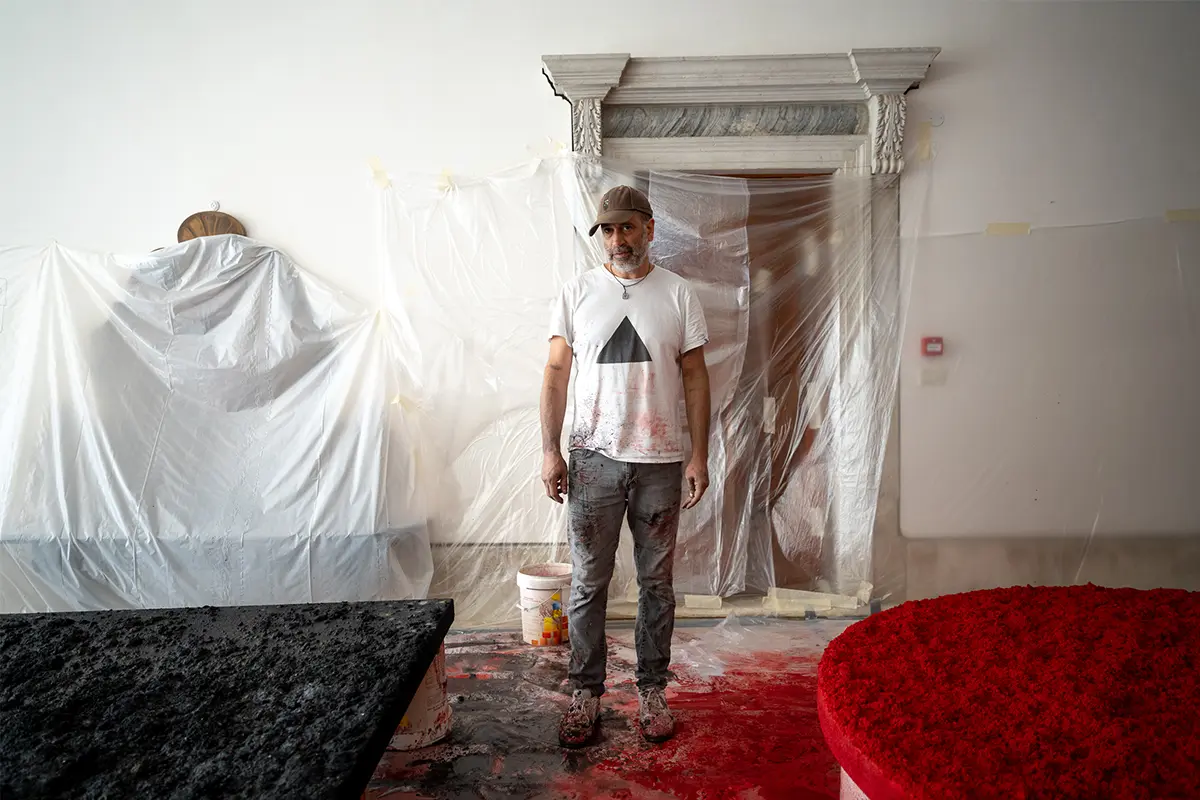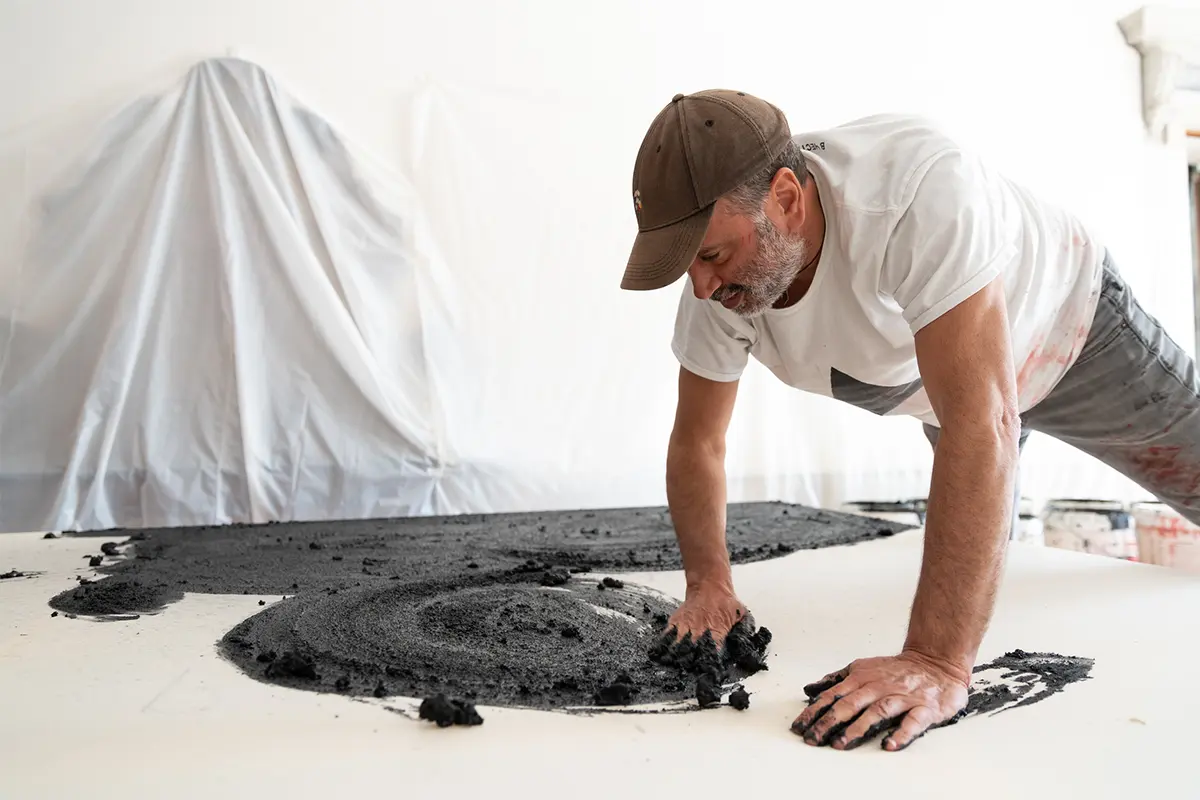Art is not fixed: Sodi’s pieces change according to the environment – and people – they are exposed to. Bosco Sodi unveils the latest show at Palazzo Vendramin Grimani in Venice
As a collateral of the Fifty-ninth Biennale di Venezia, the Fondazione dell’Albero d’Oro presents the exhibition «What Goes Around Comes Around» by Mexican artist Bosco Sodi at Palazzo Vendramin Grimani. From April 23rd to November 27th. Curated by Daniela Ferretti and Dakin Hart. The exhibition is a mixture of paintings and sculptures, in an open dialogue with the monumental rooms where the works are hosted. Sodi is known internationally for his ability to work with rough raw materials to create large-format pieces.
Bosco Sodi: the artistic Residency
The exhibition was preceded by Sodi’s artistic residency at Palazzo Vendramin Grimani. The ground floor of the venetian building was «partially transformed into an atelier», as Ferretti explains. Where he could create part of the works on show. Sodi was the first artist to be hosted in the Palazzo. The starting point of a program that the foundation wants to become permanent: «a place of cultural transmission open to artists and anyone who loves and spends time in Venice, recognizing its role as both a starting point and a destination of the imaginary and physical route connecting East and West».
Venice is an iconic place for business and cultural exchange. It has been this way for centuries. This concept also connects the foundation with Sodi himself and his work: «it revolves around the idea of exchange – with different meanings: from trade to voyage». For him, coming from Mexico, we are East. What Goes Around Comes Around, in an endless dance of exchanges that are meat to enrich. The residency lasted two weeks, between the end of February and March 2022.
Natural elements: canvases in the Palazzo
Sodi builds – the word is perhaps more fitting than paints – his canvases horizontally. Once he has chosen the shape of the canvas, he lays it out on the floor. He prepares a mixture made of pigments, glues and other natural elements such as cellulose and sawdust. He then arranges the mixture on the canvas, creating a different texture each time. The result are often gigantic monochromatic canvases covered in pigment. Some touches of gold and silver pigments on the surface.
Pure color: reality becomes art
Facing them, the viewer feels completely immersed in something undefinable: pure color, pure matter, substance. Huxley claimed art could never be fine enough to come close to reality. Sodi goes beyond this distinction: making matter not just the subject but the substance his art is made of. Reality becomes art by the sole virtue of being. For the scope of this exhibition, the artworks were left to dry on the ground floor, exposed to the lagoon and its environment. Its humidity and characteristics contribute to the final result. No further fixer was used.
Bosco Sodi showcased: about exchange
The canvases were then showcased on the upper floor, in juxtaposition with the monumental spaces of the Palazzo. The effect is raw, unfinished. The imperfection at the heart of the artwork: the real masterpiece. Sodi gives no title to his works as not to limit or direct the viewer in any way. The remaining drying and fixture happens on the wall – «the painting looks different today than it did yesterday or a week ago».
The local environment and anyone who enters the room contributes to the pieces, as if forever connected. This is also about exchange. Art is meant to leave something to the viewer, but the opposite hardly ever happens. Sodi overturns this paradigm. Viewers can see whatever they want in each piece but are forced to give back a part of themselves, for the mere fact of standing in front of it.
Matter matters and the raw
What Goes Around Comes Around is the vengeance of the raw. The pieces expose the artist rather than the opposite. Every detail is considered carefully. It starts with the choice of raw materials: pigments for the canvases and different rocks and clays for the sculptures.
Sodi only works with natural elements across all his pieces. Upon entrance, the visitor is welcomed by sculptures made out of volcanic rocks, that were selected by the artist and processed with glazing: «a whole rock was cracked and then broken into four pieces». Again, the artwork is not fixed: the cracks, stains and colors it acquires entirely depend on the environment it is exposed to. The same sculpture would look different in the venetian lagoon than in Mexico.
Bosco Sodi and Venice: connection and challenges
There is an analogy between the way Sodi’s work is made and Venice: «The city was designed thanks to the movements of water on the dryland». Similarly, Sodi’s sculptures and paintings are shaped by the interaction of the natural elements they are made of, with the ones that happen to surround them.
Building the exhibition also challenged the city and made its limits apparent. Art of it was an enormous clay sphere «which challenged the fragility of the city». The team had to carefully design spaces as not to risk the building collapse. In Venice even more than elsewhere, balance is essential.
Cochineal in Sodi: a history
One of the crucial choices Sodi made is using cochineal for his red canvases. Cochineal is a crimson pigment coming from the homonymous insect, part of the family of anthraquinone dyes. It is made by collecting the female cochineal insects from their host plants and processing them with hot water or exposure to sun, steam or a source of heat. Depending on the processing method, the color changes.
History is probably the most fascinating feature. It was imported in Europe after the Spanish conquest of Mexico, in 1521, and quickly transformed the art of dyers. At the beginning, it was not found in paintings: it was first used on textiles because of its brilliant and vivid color, and because it was particularly stable. By contrast, reds coming from European cochineals were less intense. The Mexican parasite feeds on a specific type of Cactus of the Oaxaca region. The Oaxaca region is still the main manufacturer worldwide to date.
Cochineal and Tiziano: connecting to Venice
Given that red is one of the most representative colors for Venice, it is not surprising to later find cochineal in its art. The first painter who was reportedly allowed to use cochineal on canvas is Tiziano. Coincidences with Sodi’s exhibition in Venice do not end here. In a recent study, traces of Cochineal were found in a painting by Tiziano now at the National Gallery, portraying the Vendramin family, after which Palazzo Vendramin Grimani is named.
Business and art: the role of trade
Under a business perspective, the trade of cochineal made up for one of the main sources of income of the Spanish Empire, even higher than silver. Textiles dyed with cochineal then went from Venice to the Flemish manufacture production. Cochineal, in the paintings of Sodi, stands for a connection between East and West, Mexico and Venice, but also across all European art of the Sixteenth century and beyond. It makes one more aspect clear: how conquest, business and trade impacted pigments availability and therefore the development of art history as we study it today.
Noi Siamo Uno / We Are One: geopolitics, matter, art
A composed terracotta sculpture occupies a whole room at the end of the Bosco Sodi exhibition on the upper floor of Palazzo Vendramin Grimani. It is made of one big terracotta sphere surrounded by a hundred and ninety-five smaller ones. The number is not accidental: they represent the sovereign nation states officially recognized worldwide today. Each visitor is asked to make one shift – and one only – by moving one of the smaller ‘globes.’
This way, he has a chance to change the geopolitics of the artwork in a tangible way. By contrast, the bigger, immovable sphere in the middle «represents unity». A writing on the wall reads «Noi siamo uno» (lett. We are One). The idea is to make the shifting nature of global alliances and national political trajectories visible and tangible. This is also the only titled work in the exhibition. At the end of the show, Venetian residents will be given the change to bring one of the smaller spheres home.
On the walls of Palazzo Vendramin Grimani
On the walls of the Palazzo are a few more pieces by Sodi. Some burlap bags used to store chilly – one of the main exports from Mexico – also became works of art, to which the artist committed during the pandemic. Again, no explicit explanation is given, but they could be interpreted as a reflection on the nature of intercontinental trade.
In his Mexican foundation, Sodi also hosts workshops for children, to explore potential futures in the world of art. Some of the artworks created by children were sent from Mexico and are also showcased. During the exhibition, workshops with local residents were planned, with the idea of sending the artworks by venetian kids back to Mexico to create a connection.
Casa Wabi Foundation, Puerto Escondido, designed by Tadao Ando
Back in Mexico, in the Oaxaca region, Bosco Sodi opened the Casa Wabi Foundation, a non-profit, civil association that fosters an exchange between contemporary art and local communities in Puerto Escondido, Mexico City, and Tokio. The name originates from the Japanese philosophy of Wabi-Sabi, which seeks beauty and harmony in the simple, the imperfect and the unconventional.
Sodi wanted Architect Tadao Ando to design the main building in Puerto Escondido: «The construction looks directly at the Pacific Ocean, sharing 550 meters of coastline with only the impressive beach. I have created a concrete wall 312 meters long by 3.6 meters high with that generous expanse of land. This wall creates a horizontal separation between public programs on the north and private sections on the south side. The rich red and orange sunset reflects off the concrete surface. This is a unique project, where I used various unusual materials, allowing me to create architecture and spaces that cannot be created anywhere else» explained Ando.
Fondazione Albero d’Oro
Non-for-profit cultural institution since 2010 with the aim of making Palazzo Vendramin Grimani a place of cultural transmission open to artists and anyone who loves and spends time in Venice, recognizing its role as both a starting point and a destination of the imaginary and physical route connecting East and West.




















